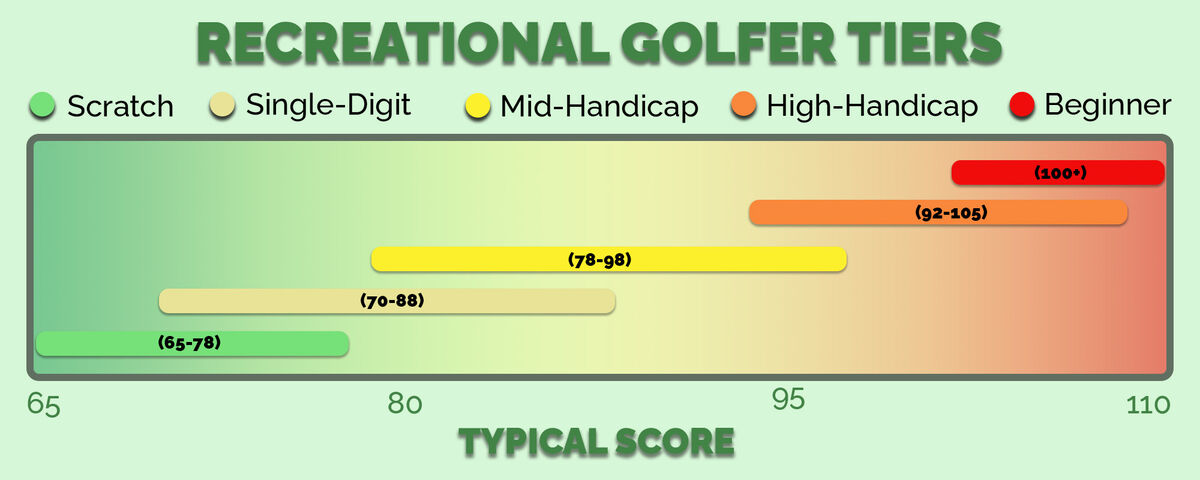The Definition of a Mid Handicap Golfer With Scores & Stats
What is a mid handicap golfer? Here's the definition and the scores and stats mid-handicappers post

Decent. Not bad. Above average. If you’re a mid-handicap golfer, these are some of the terms your playing partners likely use to describe your game.
You’re good enough that others are no longer afraid to stand five yards in front and 40 yards to the right of you while you hit an approach shot, but not good enough that when you birdie the first hole, they’re wondering if you’re breaking par that day.
If you’re a mid-handicap golfer you have some nice golf skills, but you’ve still got some work to do to break into the single-digits or win your club championship.
Definition of a Mid-Handicap Golfer
A mid-handicap golfer is a player with a handicap between 11 and 20, and someone who typically shoots scores ranging from the high 70s to the high 90s.
The Tiers of Recreational Golfers

Mid-handicap golfers are quite literally in the middle of the pack. If golf skill was rated on a scale from 1-5, mid-handicappers would be 3, sandwiched between beginners and high-handicappers on one side, and single-digit and scratch golfers on the other. Here’s a look at the handicap range and typical scores for every tier of recreational golfer.
|
Tier |
Handicap Range (Typical Score Range) |
Percent of Male Golfers |
|
Beginner |
26+ (100+) |
8% |
|
High-Handicap |
20-25 (92-105) |
13% |
|
Mid-Handicap |
11-20 (78-98) |
44% |
|
Low-Handicap |
0.1-10 (70-88) |
33% |
|
Scratch |
0.0 and better (65-78) |
2% |
If you assume that anyone who shoots a score in the 70s has graduated from the mid-handicap ranks, it’s not quite that simple. Your “mid-handicapper” title is earned by your average days, not your absolute best. To get technical, your handicap index is the average differential of your eight best rounds out of your last 20. If you just shot a personal best score of 78 from the 6,200-yard tees at Gamble Sands, with a Rating and Slope of 68.6 and 109, that differential is 9.7. When that 9.7 is averaged with seven higher differentials, your handicap is still squarely in the mid-handicap realm. But don’t fret, a few more of those 8- and 9-something differentials, and you’ll be well on your way to that elusive Single-Digit title.
On the other hand, just because a player shoots a score at the high end, or even above, the range for their tier doesn't mean they’re relegated to the next lower tier. Twelve out of your last 20 rounds – a whole 60 percent of them – don’t count toward your handicap index at all. That’s why a scratch golfer can shoot 80 on any given day without losing that hard-earned title. They just need to balance those 80s with a consistent spattering of low rounds.
Reaching the Next Level
Have you ever wondered how a single-digit handicap player’s game compares to yours, beyond the final number on the scorecard? You might not be as far off as you think from reaching the next level. Since the average male handicap is 14.2, we compared stats from the average 14-handicap player to the average 9-handicapper, the players who have just broken into the single-digit tier. Here’s how the data from Arccos golf stacks up in six key areas.
|
Stat |
9-Handicap Golfer |
14-Handicap Golfer |
|
Fairways hit |
47% |
44% |
|
Distance off the tee |
235 yards |
224 yards |
|
Greens in regulation |
38% |
28% |
|
Up & down from within 25 yards |
38% |
31% |
|
3-putts per Round |
2.5 |
3.2 |
|
Double bogey or worse per round |
2.6 |
4.2 |
That’s right, a player with a handicap index of 9 – a bonafide single-digit player – 3-putts more than once per side and cards 2.6 double bogeys per round. Proof that you don’t have to play anything close to perfect golf to get to the next level.
The biggest differences between the two levels of players is that single-digit players hit more greens in regulation, are better at getting up and down when they miss greens, and they’re better at avoiding big numbers. See how many of the 9-handicapper statistics you can achieve during your next round. The closer you get to hitting all six, the closer you’ll be to becoming a single-digit player.
Golf Equipment for Mid-Handicappers
Golf clubs and balls made for mid-handicappers offer a blend between performance and forgiveness. You’ve earned a gold star for getting the ball in the air on your own, and having at least somewhat consistent distances with each club, so you no longer need clubs and balls with the “High Launch” or “HL” label. However, you could still use some assistance with distance and prefer equipment that helps you hit straighter shots, at least until you master an on-command draw or fade as you ascend into the single-digit tier.
About 44% of male golfers who keep an official USGA handicap fall into the mid-handicap class, and the average handicap index for men is 14.2 That’s great news for fellow mid-handicappers because it means you’re the target demographic for the lion's share of golf equipment. That’s why there is always great equipment for mid-handicappers. In fact, we’ve identified some really great golf balls for mid-handicappers and the best drivers for mid-handicap golfers.
Conclusion
As a mid-handicap golfer, the highs are high, like the occasional chance of breaking 80 as you head into the final few holes. The lows, like-wise, are low, like when one aspect of your game completely refuses to cooperate for an entire round. That’s all part of golf, and the more you can consistently repeat the good stuff, the quicker you’ll climb the ladder into the single-digit world. Good luck.